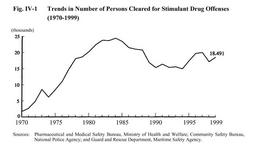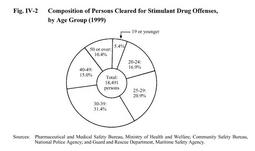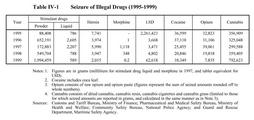| Previous Next Index Image Index Year Selection | |
|
|
1 Stimulant drug Offenses Fig. IV-1 shows the number of persons cleared by thepolice for stimulant drug offenses over the30years since 1970.
The number of persons cleared for stimulant drug offenses turned downward after peaking at24,372in1984,but has been showing an upward trend since hitting a bottom at14,896in1994. Following atemporary decline in1998,the number increased by1,407(8.2%)in1999to reach18,491. By type of violation, the use of stimulant drugs was most frequent with10,153persons cleared(54.9%), followed by possession with6,437(34.8%), transfer with1,242(6.7%), acceptance with517(2.8%)and illegal importwith94(0.5%). Fig. IV-1 Trends in Number of Persons Cleared for Stimulant Drug Offenses(1970-1999) In1999,159persons were cleared by the police for offenses resulting from the use of stimulant drugs, down by2from the previous year. Offenses most frequently committed include breaking and entering, larceny, bodily injury and destruction of property. A total of67persons were involved in accidents resulting from stimulant drug use, including traffic accidents(29persons), death caused by abuse(26)and suicide(8)(source:Community Safety Bureau, National Police Agency).Members and quasi-members of organized crime groups(hereinafter referred to as organized crime group members)cleared by the police for stimulant drug offenses in1999numbered7,944,accounting for43.4%of the total number cleared for stimulant drug offenses(up0.7points from the previous year). By type of offense,4,124organized crime group members were cleared for the use of stimulant drugs(51.9%), followed by possession with2,986persons cleared(37.6%), transfer with661(8.3%)and acceptance with148(1.9%)(source:Community Safety Bureau, National Police Agency). In1999,509visiting foreigners(as defined in Part4Section2-2 )were cleared for stimulant drug offenses, down by100(16.4%)from the previous year. By nationality, Iranians had the largest share(26.9%)with137persons cleared, followed by Philippine nationals(136persons cleared,26.7%)(source:International Affairs Department, Director-General's Secretariat, National Police Agency). Fig. IV-2 shows the number of persons cleared for stimulant drug offenses in1999by age group.1,003of them were aged19or younger(down by76from the previous year), including81senior high school students(down by22)and24junior high school students(down by15). Fig. IV-2 Composition of Persons Cleared for Stimulant Drug Offenses, by Age Group(1999) Table IV-1 shows the volume of major drugs seized since 1995.Table IV-1 Seizure of Illegal Drugs(1995-1999) 35of the cases in1999involved bulk seizure(1kg or more)of stimulant drugs, with a total volume of1,974.8kg. By origin of import(that is, the country or region including the presumed place of origin), China accounted for13cases(935.8kg), North Korea for2cases(664.6kg), and Taiwan and Singapore for1case each(2.1kg). The place of origin has not been identified for the remaining18cases(370.2kg). Cumulative data for the last five years indicate that China is the largest origin of drugs seized in bulk cases(71.6%), followed by North Korea with28.3%(source:Community Safety Bureau, National Police Agency, and Guard and Rescue Department, Maritime Safety Agency). |


